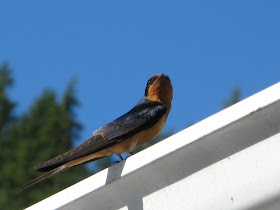 Mom and "her cat" Stick Tail have been coming to visit us in Powell River for the last four years. We all pile into Mom's car, lovingly called Bertha, and take the short (about 240 kilometres) but long (two ferris and 7 hours) trip. Riding in a car isn't Stick's favourite thing (you can hear his protests from quite a distance), but he finally relaxes on the back seat, sleeping most of the way.
Mom and "her cat" Stick Tail have been coming to visit us in Powell River for the last four years. We all pile into Mom's car, lovingly called Bertha, and take the short (about 240 kilometres) but long (two ferris and 7 hours) trip. Riding in a car isn't Stick's favourite thing (you can hear his protests from quite a distance), but he finally relaxes on the back seat, sleeping most of the way. The highlight of the trip north is visiting the float cabin. Stick has to stay in his carrier for the boat ride up the lake, but gets lots of comfort on Mom's lap. Once at the cabin, he settles right in. The beauty of the float cabin is that it is surrounded by water. Back in Bellingham, Stick has to stay indoors all of the time because Mom has an apartment style condo. But at the float cabin, he's able to have the run of the place.
The highlight of the trip north is visiting the float cabin. Stick has to stay in his carrier for the boat ride up the lake, but gets lots of comfort on Mom's lap. Once at the cabin, he settles right in. The beauty of the float cabin is that it is surrounded by water. Back in Bellingham, Stick has to stay indoors all of the time because Mom has an apartment style condo. But at the float cabin, he's able to have the run of the place.  For Stick, the cabin is like a giant cat climbing apparatus. He loves the stairs (the first he has ever known) and gets a kick out of running up and getting a "birds-eye" view from the loft. At first, he was very cautious outdoors, but now he is comfortable in his vacation home. He even explores underneath the float (that's where the mousies live). One trip he did give us quite a scare. He hopped the floating logs to shore and started climbing our cliff. But a few good warning shots with rocks brought him scurrying for home.
For Stick, the cabin is like a giant cat climbing apparatus. He loves the stairs (the first he has ever known) and gets a kick out of running up and getting a "birds-eye" view from the loft. At first, he was very cautious outdoors, but now he is comfortable in his vacation home. He even explores underneath the float (that's where the mousies live). One trip he did give us quite a scare. He hopped the floating logs to shore and started climbing our cliff. But a few good warning shots with rocks brought him scurrying for home. I'm always amazed at how quick Stick Tail adjusts to new environments. After only a few hours inside the cabin, he is allowed undisturbed exploration. Usually after one day he has a favorite sleeping place. And the litter box has always been found without any "accidents." A friend warned me that cats don't adjust to new places very well, but Stick has done exceptionally well between his three homes: a condo in Bellingham, a condo in Powell River, and a float cabin up the lake.
I'm always amazed at how quick Stick Tail adjusts to new environments. After only a few hours inside the cabin, he is allowed undisturbed exploration. Usually after one day he has a favorite sleeping place. And the litter box has always been found without any "accidents." A friend warned me that cats don't adjust to new places very well, but Stick has done exceptionally well between his three homes: a condo in Bellingham, a condo in Powell River, and a float cabin up the lake. Our cabin on Powell Lake is a very special place for all of us. It even inspired my husband Wayne to write the Coastal BC Stories series. You too can head Up the Lake and Farther Up the Lake through his books.
Our cabin on Powell Lake is a very special place for all of us. It even inspired my husband Wayne to write the Coastal BC Stories series. You too can head Up the Lake and Farther Up the Lake through his books.We'll all be lounging in the sun and swimming in the lake (well, maybe not Stick unless he falls in) for a few glorious days, so you won't be seeing any blog posts for a while.
What are you doing this summer (or winter as it may be for my readers south of the equator)? No matter which season, I hope you have a great week. -- Margy







 Whether using old fashioned fishing skills or new fangled technology, the fish are here. Powell Lake is open from April 1 to October 31. You will need a
Whether using old fashioned fishing skills or new fangled technology, the fish are here. Powell Lake is open from April 1 to October 31. You will need a 






































